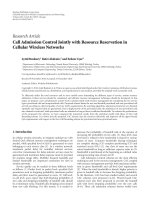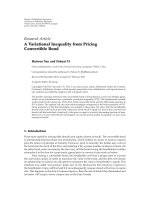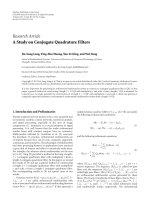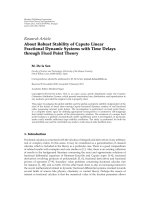Báo cáo hóa học: "Research Article Recurring Mean Inequality of Random Variables" doc
Bạn đang xem bản rút gọn của tài liệu. Xem và tải ngay bản đầy đủ của tài liệu tại đây (467.48 KB, 6 trang )
Hindawi Publishing Corporation
Journal of Inequalities and Applications
Volume 2008, Article ID 325845, 6 pages
doi:10.1155/2008/325845
Research Article
Recurring Mean Inequality of Random Variables
Mingjin Wang
Department of Applied Mathematics, Jiangsu Polytechnic University, Changzhou, Jiangsu 213164, China
Correspondence should be addressed to Mingjin Wang,
Received 16 August 2007; Revised 25 February 2008; Accepted 9 May 2008
Recommended by Jewgeni Dshalalow
A multidimensional recurring mean inequality is shown. Furthermore, we prove some new
inequalities, which can be considered to be the extensions of those established inequalities,
including, for example, the Polya-Szeg
¨
o and Kantorovich inequalities .
Copyright q 2008 Mingjin Wang. This is an open access article distributed under the Creative
Commons Attribution License, which permits unrestricted use, distribution, and reproduction in
any medium, provided the original work is properly cited.
1. Introduction
The theory of means and their inequalities is fundamental to many fields including
mathematics, statistics, physics, and economics.This is certainly true in the area of probability
and statistics. There are large amounts of work available in the literature. For example,
some useful results have been given by Shaked and Tong 1, Shaked and Shanthikumar
2,Shakedetal.3, and Tong 4, 5. Motivated by different concerns, there are numerous
ways to introduce mean values. In probability and statistics, the most commonly used mean
is expectation. In 6, the author proves the mean inequality of two random variables. The
purpose of the present paper is to establish a recurring mean inequality, which generalizes the
mean inequality of two random variables to n random variables. This result can, in turn, be
extended to establish other new inequalities, which include generalizations of the Polya-Szeg
¨
o
and Kantorovich inequalities 7.
We begin by introducing some preliminary concepts and known results which can also
be found in 6.
Definition 1.1. The supremum and infimum of the random variable ξ are defined as inf
x
{x : Pξ ≤
x1} and sup
x
{x : Pξ ≥ x1}, respectively, and denoted by sup ξ and inf ξ.
Definition 1.2. If ξ is bounded, the arithmetic mean of the random variable ξ, Aξ, is given by
Aξ
sup ξ inf ξ
2
. 1.1
2 Journal of Inequalities and Applications
In addition, if inf ξ ≥ 0, one defines the geometric mean of the random variable ξ, Gξ,tobe
Gξ
sup ξ· inf ξ. 1.2
Definition 1.3. If ξ
1
, ,ξ
n
are bounded random variables, the independent arithmetic mean of the
product of random variables ξ
1
, ,ξ
n
, Aξ
1
, ,ξ
n
is given by
A
ξ
1
, ,ξ
n
n
i1
sup ξ
i
n
i1
inf ξ
2
. 1.3
Definition 1.4. If ξ
1
, ,ξ
n
are bounded random variables with inf ξ
i
≥ 0,i 1, ,n, one defines
the independent geometric mean of the product of random variables ξ
1
, ,ξ
n
to be
G
ξ
1
, ,ξ
n
n
i1
sup ξ
i
inf ξ
i
. 1.4
Remark 1.5. If ξ
1
, ,ξ
n
are independent, then
A
ξ
1
, ,ξ
n
A
n
i1
ξ
i
,
G
ξ
1
, ,ξ
n
G
n
i1
ξ
i
.
1.5
The mean inequality of two random variables 6.
Theorem 1.6. Let ξ and η be bounded random variables. If inf ξ>0 and inf η>0,then
Eξ
2
·Eη
2
E
2
ξη
≤
A
2
ξ, η
G
2
ξ, η
. 1.6
Equality holds if and only if
P
ξ
η
a
B
ξ
η
A
b
1,
G
η
2
Eξ
2
G
ξ
2
Eη
2
1.7
for A sup ξ, B sup η, a inf ξ, b inf η.
2. Main results
Our main results are given by the following theorem.
Theorem 2.1. Suppose that ξ
1
, ,ξ
n
,ξ
n1
are bounded random variables, inf ξ
i
> 0,i 1, ,n 1.
Let {Un} be a sequence of real numbers. If
n
i1
Eξ
2
i
E
2
n
i1
ξ
i
≤ Un, 2.1
then
n1
i1
Eξ
2
i
E
2
n1
i1
ξ
i
≤
A
2
ξ
1
, ,ξ
n1
G
2
ξ
1
, ,ξ
n1
Un. 2.2
Mingjin Wang 3
Proof. Let A
i
sup ξ
i
,a
i
inf ξ
i
,i 1, ,n 1. We have
P
ξ
1
···ξ
n
A
n1
− a
1
···a
n
ξ
n1
A
1
···A
n
ξ
n1
− ξ
1
···ξ
n
a
n1
≥ 0
1. 2.3
So
P
A
1
···A
n1
a
1
···a
n1
ξ
1
···ξ
n1
≥ A
1
a
1
···A
n
a
n
ξ
2
n1
A
n1
a
n1
ξ
2
1
···ξ
2
n
1, 2.4
which implies that
A
1
···A
n1
a
1
···a
n1
E
ξ
1
···ξ
n1
≥ A
1
a
1
···A
n
a
n
E
ξ
2
n1
A
n1
a
n1
E
ξ
2
1
···ξ
2
n
. 2.5
Using the Jensen inequality 7 and assumption 2.1,weget
A
1
···A
n1
a
1
···a
n1
E
ξ
1
···ξ
n1
≥ A
1
a
1
···A
n
a
n
E
ξ
2
n1
A
n1
a
n1
E
2
ξ
1
···ξ
n
≥ A
1
a
1
···A
n
a
n
E
ξ
2
n1
A
n1
a
n1
Eξ
2
1
···Eξ
2
n
Un
≥ 2
A
1
a
1
···A
n
a
n
E
ξ
2
n1
A
n1
a
n1
Eξ
2
1
···Eξ
2
n
Un
1/2
.
2.6
Hence,
G
2
ξ
1
, ,ξ
n1
Eξ
2
1
···Eξ
2
n1
Un
1/2
≤ A
ξ
1
, ,ξ
n1
E
ξ
1
···ξ
n1
, 2.7
from which 2.2 follows.
Combining this result with Theorem 1.6, the following recurring inequalities are
immediate.
Corollary 2.2. Let ξ
1
, ,ξ
n
be bounded random variables. If inf ξ
i
> 0, i 1, ,n,then
Eξ
2
1
Eξ
2
2
E
2
ξ
1
ξ
2
≤
A
2
ξ
1
,ξ
2
G
2
ξ
1
,ξ
2
,
Eξ
2
1
Eξ
2
2
Eξ
2
3
E
2
ξ
1
ξ
2
ξ
3
≤
A
2
ξ
1
,ξ
2
,ξ
3
G
2
ξ
1
,ξ
2
,ξ
3
A
2
ξ
1
,ξ
2
G
2
ξ
1
,ξ
2
,
.
.
.
n
k1
Eξ
2
k
E
2
n
k1
ξ
k
≤
n
k2
A
2
ξ
1
, ξ
k
G
2
ξ
1
, ξ
k
.
2.8
4 Journal of Inequalities and Applications
3. Some applications
In this section, we exhibit some of the applications of the inequalities just obtained. We make
use of the following known lemma which we state here without proof.
Lemma 3.1. If 0 <m
2
≤ m
1
≤ M
1
≤ M
2
,then
1/2
m
1
M
1
m
1
M
1
≤
1/2
m
2
M
2
m
2
M
2
. 3.1
Theorem 3.2 the extensions of the inequality of Polya-Szeg
¨
o. Let a
ij
> 0,a
i
min
j
a
ij
,A
i
max
j
a
ij
,fori 1, ,nand j 1, ,m.Then,
n
i1
m
j1
a
2
ij
≤
m
n−2
4
n−1
n
k2
a
1
···a
k
A
1
···A
k
2
a
1
···a
k
A
1
···A
k
m
j1
n
i1
a
ij
2
. 3.2
Proof. This result is a consequence of inequality 2.8.Letξ
1
have the distribution
P
ξ
1
a
1j
1
m
,j 1, ,m. 3.3
We define n − 1 functions as follows:
f
i
a
1j
a
ij
,i 2, ,n, j 1, ,m. 3.4
Let ξ
i
f
i
ξ
1
,i 2, ,n. Then,
Eξ
2
i
1
m
m
j1
a
2
ij
,i 1, ,n,
E
ξ
1
···ξ
n
1
m
m
j1
n
i1
a
ij
,
A
ξ
1
, ,ξ
k
1
2
a
1
···a
k
A
1
···A
k
,
G
ξ
1
, ,ξ
k
a
1
···a
k
A
1
···A
k
.
3.5
Inequality 2.8 then becomes
n
i1
1/m
m
j1
a
2
ij
1/m
m
j1
n
i1
a
ij
2
≤
n
k2
1/2
a
1
···a
k
A
1
···A
k
2
a
1
···a
k
A
1
···A
k
2
, 3.6
from which our result follows.
Remark 3.3. For n 2, we can get the inequality of Polya-Szeg
¨
o 7:
m
k1
a
2
k
m
k1
b
2
k
≤
1
4
AB
ab
ab
AB
2
m
k1
a
k
b
k
2
, 3.7
where a
k
,b
k
> 0,k 1, ,m, a min a
k
,A max a
k
,b min b
k
,andB max b
k
.
Mingjin Wang 5
Theorem 3.4 the extensions of Kantorovich’s inequality. Let A be an m × m positive Hermitian
matrix. Denote by λ
1
and λ
m
the maximum and minimum eigenvalues of A, respectively. For real
β
1
, ,β
n
and β β
1
··· β
n
, and any vector 0
/
x ∈ R
m
,the following inequality is satisfied:
n
i1
x
∗
A
β
i
x
x
∗
A
β/2
x
2
≤
x
∗
x
n−2
4
n−1
n
k2
l
1
···l
k
L
1
···L
k
2
l
1
···l
k
L
1
···L
k
, 3.8
where
l
i
⎧
⎨
⎩
λ
β
i
/2
m
,β
i
≥ 0,
λ
β
i
/2
1
,β
i
< 0,
L
i
⎧
⎨
⎩
λ
β
i
/2
1
,β
i
≥ 0,
λ
β
i
/2
m
,β
i
< 0,
i 1, ,n. 3.9
Proof. Let λ
1
≥ ··· ≥λ
m
be eigenvalues of A and let Λdiagλ
1
, ,λ
m
. There is a Hermitian
matrix U that satisfies
A U
∗
ΛU. 3.10
Let
y Ux
y
1
,y
2
, ,y
m
T
,p
i
y
i
2
m
i1
y
i
2
,i 1, ,m. 3.11
Then,
n
i1
x
∗
A
β
i
x
x
∗
A
β/2
x
2
n
i1
x
∗
U
∗
Λ
β
i
Ux
x
∗
U
∗
Λ
β/2
Ux
2
n
i1
y
∗
Λ
β
i
y
y
∗
Λ
β/2
y
2
y
∗
y
n−2
n
i1
m
k1
λ
β
i
k
p
k
m
k1
λ
β/2
k
p
k
2
x
∗
x
n−2
n
i1
m
k1
λ
β
i
k
p
k
m
k1
λ
β/2
k
p
k
2
.
3.12
What remains to show is that
n
i1
m
k1
λ
β
i
k
p
k
m
k1
λ
β/2
k
p
k
2
≤
1
4
n−1
n
k2
l
1
···l
k
L
1
···L
k
2
l
1
···l
k
L
1
···L
k
, ∀p
i
≥ 0,
m
i1
p
i
1. 3.13
We define the random variable ζ, and assign Pζ λ
i
p
i
,i 1, ,m. Suppose ξ
i
ζ
β
i
/2
,i 1, ,n.Notice that λ
1
and λ
n
are the upper and lower bounds of the random variable
ζ,sol
i
and L
i
are the lower and upper bounds of ξ
i
. According to Lemma 3.1, we know that
A
2
ξ
1
, ,ξ
k
G
2
ξ
1
, ,ξ
k
≤
1/2
l
1
···l
k
L
1
···L
k
2
l
1
···l
k
L
1
···L
k
2
. 3.14
6 Journal of Inequalities and Applications
Noticing that
E
ξ
1
···ξ
n
Eζ
β/2
m
k1
λ
β/2
k
p
k
, 3.15
we can use inequality 2.8 to express inequality 3.13 as
Eξ
2
1
···Eξ
2
n
E
2
ξ
1
···ξ
n
≤
n
k2
1/2
l
1
···l
k
L
1
···L
k
2
l
1
···l
k
L
1
···L
k
2
. 3.16
Remark 3.5. If n 2,β
1
1, and β
2
−1, this inequality takes the form
x
∗
Axx
∗
A
−1
x
x
∗
x
2
≤
λ
1
λ
m
2
4λ
1
λ
m
3.17
which is Kantorovich’s inequality 7.
References
1 M. Shaked and Y. L. Tong, “Inequalities for probability contents of convex sets via geometric average,”
Journal of Multivariate Analysis, vol. 24, no. 2, pp. 330–340, 1988.
2 M. Shaked and J. G. Shanthikumar, Stochastic Orders and Their Applications, Probability and
Mathematical Statistics, Academic Press, Boston, Mass, USA, 1994.
3 M. Shaked, J. G. Shanthikumar, and Y. L. Tong, “Parametric Schur convexity and arrangement
monotonicity properties of partial sums,” Journal of Multivariate Analysis, vol. 53, no. 2, pp. 293–310,
1995.
4 Y. L. Tong, “Some recent developments on majorization inequalities in probability and statistics,” Linear
Algebra and Its Applications, vol. 199, supplement 1, pp. 69–90, 1994.
5 Y. L. Tong, “Relationship between stochastic inequalities and some classical mathematical inequalities,”
Journal of Inequalities and Applications, vol. 1, no. 1, pp. 85–98, 1997.
6 M. Wang, “The mean inequality of random variables,” Mathematical Inequalities & Applications,vol.5,
no. 4, pp. 755–763, 2002.
7 G. H. Hardy, J. E. Littlewood, and G. P
´
olya, Inequalities, Cambridge University Press, Cambridge, UK,
2nd edition, 1952.









